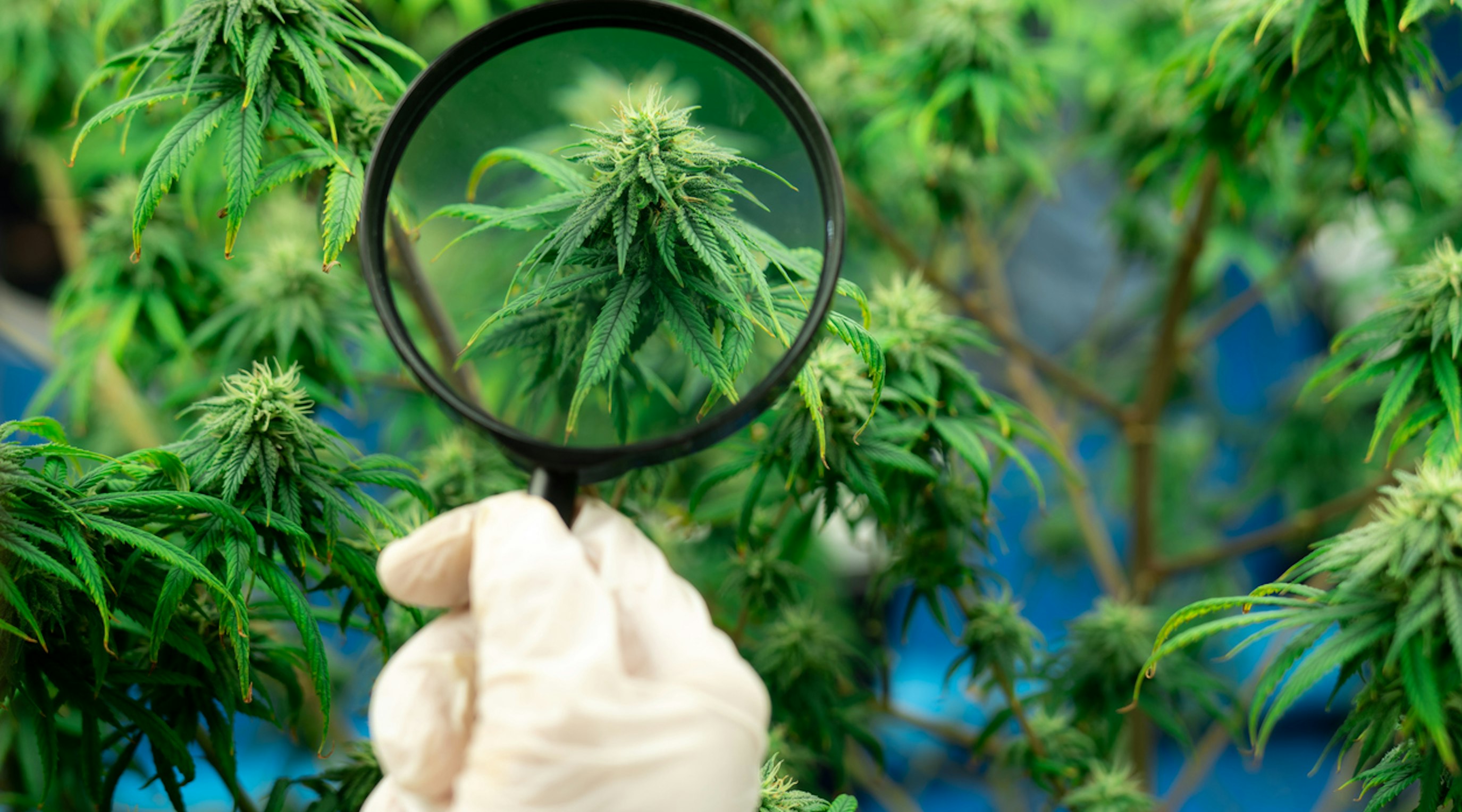Understanding the lingo: medical cannabis terminology
9 min read
Emily Ledger
Cannabis-based remedies are mentioned as far back as the Ancient Egyptians and Ancient Greeks. In fact, the earliest mention of medical cannabis is believed to date back even further to the time of the Ancient Chinese Emperor Shen Nung - known as the Father of Chinese Medicine - almost 5,000 years ago!
The medical cannabis landscape today, however, looks a lot different to how it did back then. Aside from patchwork laws and regulations around the world, the seemingly endless medical cannabis terminology often leaves the world of medical cannabis feeling alien to many.
Contents
Why is it important to understand medical cannabis terminology?
Starting an unfamiliar treatment like medical cannabis can be a daunting experience - especially given the many terms associated with the medical sector. Even those with a history of using illicit cannabis products to manage their condition can understandably find medical jargon confusing and overwhelming.
So, let’s take a look at some of the most common and important medical cannabis terms and explain what they mean in more detail.
Medical cannabis terms
Cannabis compounds
Cannabis is a complex botanical that contains hundreds of active compounds - many of which have been found to possess significant therapeutic potential. These include:
Cannabinoids: The term “cannabinoids” refers to a specific class of chemical compounds that interact with cannabinoid receptors within human and animal bodies. These can be produced within our bodies (endogenous or endocannabinoids) or plants (phytocannabinoids).
The cannabis plant produces over 140 different cannabinoids, the most well-known of which are:
Tetrahydrocannabinol (THC): A major cannabinoid known for its psychoactive effects, being the main compound behind the “high” associated with cannabis use. It also possesses a wide range of therapeutic properties which make the cannabinoid a key focus of medicinal use and research.
The abbreviation “THC” is generally used to refer to delta-9 tetrahydrocannabinol. Another form, delta-8 tetrahydrocannabinol, is usually referred to as “delta-8 THC”.
Cannabidiol (CBD): Another major cannabinoid, CBD is a non-intoxicating cannabis compound. Like THC, it has several proven medicinal benefits and can be prescribed for the treatment of a number of conditions.
Minor Cannabinoids: While CBD and THC are the most well-known and well-researched phytocannabinoids, there are over 100 other cannabinoids to be found in the cannabis plant. These include cannabigerol (CBG), cannabichromene (CBC), cannabinol (CBN), cannabidivarin (CBDV), cannabidiolic acid (CBCA), cannabigerolic acid (CBCA), tetrahydrocannabivarin (THCV), and tetrahydrocannabinolic acid (THCA).
Terpenes: Terpenes are a type of compound found in a huge range of plants, including cannabis. They contribute to the aroma and flavour of different plants and have been found to possess impressive therapeutic potential.
Some common cannabis terpenes and their therapeutic properties include:
- Myrcene: possesses anticarcinogen, antioxidant and pain-relieving properties
- Limonene: potential antibacterial, anti-inflammatory, antidepressant and anti-anxiety properties
- Linalool: anti-inflammatory, anti-cancer, anti-anxiety, and pain-relieving properties
- Pinene: potential anti-inflammatory, antimicrobial, and bronchodilator effects
- Humulene: anti-tumour, anti-inflammatory, and antibacterial potential
- Terpinolene: antioxidant and potential anticancer properties
Cannabis and the body
Endocannabinoid system (ECS): The ECS is the largest neurochemical system in our bodies, made up of receptors (cannabinoid receptor 1 - or CB1, and cannabinoid receptor 2 - CB2), endocannabinoids, and metabolic enzymes. Expressed throughout our central nervous system and immune system, the ECS plays a key role in processes such as mood, pain, sleep, temperature, and much more.
Endocannabinoids: Our bodies produce a huge range of chemicals to support various vital biological processes, including endogenous cannabinoids. These interact with cannabinoid receptors to trigger a number of physiological and cognitive changes.
The two most well-known endocannabinoids are 2-Arachidonoylglycerol (2-AG) and Anandamide.
Entourage effect: As mentioned earlier, cannabis contains a huge number of potentially therapeutic compounds, including cannabinoids and terpenes. While each of these compounds possesses its own properties, some research indicates that, when consumed together, they can work synergistically to enhance the overall effects - this is known as the “entourage effect”.
Cannabis medicines
Medical cannabis can come in a number of forms in the UK and other countries around the world, including in its natural “flower state” and as pharmaceutical cannabis products. Some of the most common cannabis medicines include:
Epidyolex: Also known as “Epidiolex” in the US, Epidyolex is a UK-manufactured CBD-based medicine that can legally be prescribed for the treatment of two rare, drug-resistant epilepsies: Lennox-Gastaut syndrome and Dravet syndrome.
Nabilone: A synthetic version of THC that is licensed as a medicine in the UK to treat chemotherapy-induced nausea and vomiting.
Sativex: The brand name for nabiximols - an oromucosal spray that can be prescribed in the UK to treat spasticity in patients with multiple sclerosis (MS).
Types of cannabis
Chemotype: The term “chemotype” describes the subspecies of the same plant that produce different quantities of chemical components in their essential oils. When categorising cannabis based on its most abundant cannabinoid, there are three cannabis chemotypes: Type 1 (THC-dominant), Type 2 (Balanced CBD:THC), and Type 3 (CBD-dominant).
Cultivar: A horticultural term referring to plants that have been intentionally cultivated for specific characteristics. For example, cannabis cultivars may have been selectively bred for their cannabinoid and terpene content.
Strain: A colloquial term used in both the legal and illicit cannabis industries to describe different species or sub-families of cannabis. In the legacy market, strain names include the likes of White Widow, Birthday Cake, and Sour Diesel.
Hemp: Hemp is a member of the Cannabis Sativa L. family that has been cultivated for thousands of years for its many industrial uses. It contains low levels of THC (though often high levels of other cannabinoids, including CBD), allowing it to be grown legally in many countries (albeit with a license).
Sativa: Considered one of the three main cannabis species (see Indica and Ruderalis below), Sativa cannabis plants are the most common cannabis plants in the Western world and are taller with longer leaves than other species.
Indica: Another cannabis species, Indica gets its name from its likely origins around India, Pakistan, and Afghanistan. Indica cannabis plants are shorter than Sativa plants.
Ruderalis: The last of the three main cannabis sub-species, Cannabis Ruderalis is native to Central and Eastern Europe and Russia. They contain relatively low levels of cannabinoids but may be used in cultivation due to their auto-flowering abilities.
Cannabis administration
Given the many different forms of cannabis, it is unsurprising that there are also a wide range of administration options, including:
Vaping / Vaporising: Now among the most popular administration methods for medical cannabis, vaping allows consumers to inhale cannabinoid and terpene-rich vapour from gently heated plant matter.
Transdermal: Refers to the route of administration through absorption into the skin for local or systemic distribution of a compound. Transdermal medicines come in the form of creams and ointments - this may also be known as topical administration. Nicotine and hormone replacement therapy (HRT) patches also use transdermal administration.
Sublingual: Literally meaning “under tongue”, this route of administration involves applying an oil, spray, or tablet under the tongue. The thin skin barrier in this area allows active ingredients to quickly absorb into the bloodstream. Sublingual CBD or cannabis products tend to be in the form of a tincture or an oromucosal spray.
Buccal administration utilises a similar route between the gums and the inner lining of the mouth.
Titration: A treatment method that involves gradually increasing or decreasing the dose of a certain medicine until optimum results are achieved. This method is often crucial for effective medical cannabis treatment.
“Street” cannabis terms
In the legacy market, cannabis can come in an even broader range of forms. These include:
Hashish / Hash: a concentrated form of cannabis made by separating the trichomes from the leaves of the plants. The trichomes are then compressed into a solid block which is often smoked or vaporised.
Concentrates: Also called “extracts”, concentrates are made by extracting the cannabinoid-rich oils from the cannabis plant, resulting in a concentrated cannabinoid product. Depending on their processing, concentrates can come in a number of forms, including wax, shatter, rosin, and oils.
Cannabis-based medicines and commercial CBD products can also come in the form of different concentrates (usually oils). These can be full-spectrum, broad-spectrum, or isolate concentrates, depending on the cannabinoids and terpenes in the end product.
Edibles: Cannabis or cannabinoid-containing food or drink products. Edibles may contain concentrated CBD or THC, or full- and broad-spectrum extracts.
Sinsemilla: Once fertilised, female plants begin to produce seeds, the effort of which results in lower cannabinoid concentrations in the leaves and flowers of the plant. For this reason, unfertilised female cannabis plants are routinely used in cannabis cultivation. These are known as sinsemilla plants - literally Spanish for “seedless”.
Additional thoughts
In addition to the many terms mentioned in this article, cannabis also has a huge number of nicknames, some of which may be familiar. These include: weed, marijuana, pot, ganja, herb, grass, reefer, Mary Jane, bud, nug, and dope, among many more!
Some medicinal consumers may also use these terms to refer to their cannabis use; for example: medical weed, medical marijuana, medical hashish, etc. However, it is important to note that only cannabis-based products that are prescribed by a specialist doctor are legal for consumption in the UK.
Share article
Did you like this article?
It is important to seek medical advice before starting any new treatments. The patient advisors at Releaf are available to provide expert advice and support. Alternatively, click here to book a consultation with one of our specialist doctors.
Elevate your wellness with medical cannabis
Get comprehensive care, convenience, and confidence with an all-in-one treatment plan.
Am I eligible?Authors
Emily, an accomplished content writer with a specialisation in cannabis and alternative health, leverages her five years in the sector to enhance education and diminish stigma around medicinal cannabis use.
Editorial Policy
All of our articles are written by medical cannabis experts, guided by strict sourcing guidelines, and reference peer-reviewed studies and credible academic research. Our expert clinical team and compliance specialists provide valuable insights to ensure accuracy when required. Learn more in our editorial policy.
Need more help?










